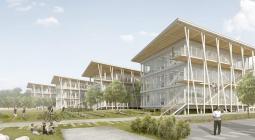Transforming our buildings: Europe’s path to sustainability
The cities of Amsterdam, Stockholm and Nantes offer good examples of how meaningful progress towards decarbonising the building sector can be achieved, while advancing the EU’s broader climate objectives, writes Irene García.
Irene García leads “Built Environment Lead” at the Carbon Neutral Cities Alliance.
As resistance mounts against the European Union’s ambitious climate agenda, the recent communication from the European Commission regarding the EU’s 2040 climate target brings hope. It commits to nearly eliminating greenhouse gas emissions by 2040, propelling the EU closer to its goal of achieving climate neutrality by 2050.
With the building sector accounting for 36% of the EU’s greenhouse gas emissions and 42% of the energy consumed, it is crucial for the Commission to prioritise this sector in its 2040 climate action plan and accelerate efforts by 2030.
Central to this approach is the continued focus on implementing the revised Energy Performance of Buildings Directive. This directive mandates that all new buildings in the EU must be zero-emission by 2030, with all new public buildings achieving this status by 2027. The directive also establishes minimum EU-level efficiency standards, which will drive an increase in the renovation rate of underperforming buildings.
These measures are essential for achieving meaningful progress towards decarbonisation in the building sector and advancing the EU’s broader climate objectives. They also help us respond to the prolonged high temperatures that are increasingly common, with extreme heat becoming the norm across the globe.
Scorching summers and chilly winters have posed challenges, particularly in places like schools, where inadequate shading and ventilation lead to uncomfortably hot classrooms. The fear of exorbitant energy bills leads some to forego heating altogether. Instead of sustainable solutions, temporary fixes like energy electricity providers offering electric blankets are common responses, which fail to address the root issues.
Uncomfortable living conditions and high energy costs become a witness to the poor building design and material choices we have made. They highlight how inefficient structures that shelter us impact our health and overall well-being, while contributing significantly to climate change. We need to reimagine our built environment, then, in a holistic way. It’s not just about how it looks. We should design them to last, to create comfort and to be future-proof.
Thankfully, forward-thinking cities are leading the way in adopting innovative approaches to construction and the urban landscape.
Amsterdam, for instance, is currently grappling with a substantial renovation and insulation task. The city is exploring ways to stimulate the widespread adoption of circular and bio-based insulation materials in retrofitting both private and social housing.
The goal is to equip relevant stakeholders, including homeowners’ associations and housing corporations, with practical data to make informed choices about insulation materials that minimise heating and cooling demands, actively contribute to our well-being, and have lower carbon footprint benefits. These materials include cellulose, grass, hemp, wood fiber, cotton, reed, straw, and flax, which offer health benefits, non-toxic properties, and efficient temperature regulation.
In Stockholm, in the area of Kollkajen, where the ships came and the coal was unloaded, the city has carried out a tremendous transformation to remediate the soil and groundwater. Material suppliers are mandated to disclose the toxicity of their products, ensuring environmental safety. And the city collaborates with industry professionals to develop innovative solutions.
Today, about 7,000 people are living in this area full of green and blue infrastructure, which plays a key role in recreation, biological diversity and stormwater management and supports the health and well-being of their residents.
Nantes, meanwhile, aims to provide comprehensive renovation services, guide owners in informed decision-making, and provide temporary housing solutions. Ongoing efforts include developing high-quality prescriptions for bio-based construction, enhancing professional skills, and establishing reference guides for tenders.
There’s a focus on promoting exemplary operations with low-carbon materials and promoting collaborative action involving various stakeholders like syndics, architects, project managers, engineering firms and citizens to explore, develop and implement solutions. As an example, the inspiring “Grand débat: Fabrique de nos villes” engaged over 30,000 participants and 620 contributions last year to propose a roadmap for a more sustainable, inclusive, and resilient Nantes.
The shift towards sustainable buildings is not just an environmental imperative. It’s an investment in the well-being and resilience of our communities. The time to act is now, and the European Commission’s commitment to the 2040 climate target, coupled with the revision of the EPBD, sets a promising precedent for sustainable change.
Achieving these ambitious goals requires concerted efforts at all levels of governance. With cities like Amsterdam, Stockholm, Nantes and many others pioneering initiatives to transform their built environments, we are witnessing the power of leadership and vision in reshaping our urban landscapes.
By providing extra support and resources to cities, we can empower them to implement sustainable solutions effectively. This collaboration between EU leadership and city-level initiatives is essential for driving meaningful progress towards a sustainable future. Together, let’s seize this opportunity to unlock a sustainable present and future.
Cover photo: The building sector accounts for 36% of the EU's greenhouse gas emissions and 42% of the energy consumed. [Photo credit: VPales/shutterstock.com]




